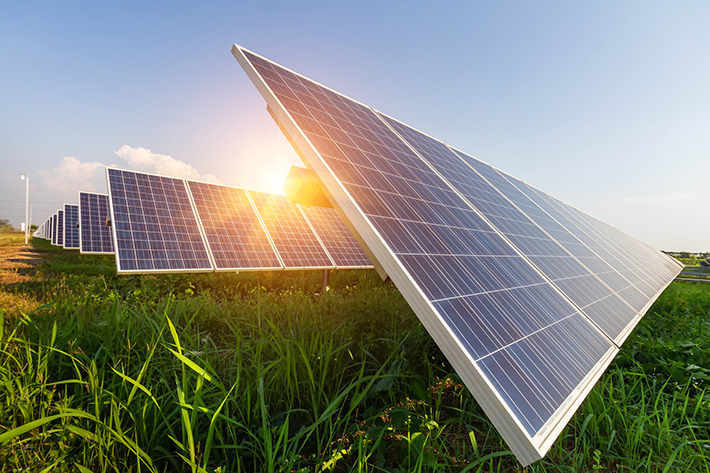
Shaping the Future of Solar Power
The world is in the midst of a renewable energy renaissance.
According to the International Energy Agency (IEA), in the first quarter of 2020, global use of renewable energy rose by nearly 1.5% compared to the same period in 2019, despite the COVID-19 outbreak reducing energy usage across the board. New solar and wind projects coming online this year have boosted renewable electricity generation by 3%, and the IEA estimates that total global use of renewable energy will rise by about 1% in 2020.
In the U.S., renewables are the fastest-growing energy source, doubling since 2000. According to the Center for Climate and Energy Solutions, that accounts for more than 17% of all U.S. electricity. Solar power is leading the way and is expected to make up as much as 48% of U.S. renewable energy generation by 2050.
However, with the increasing adoption of solar technologies, however, has come a new problem: disposing of used and worn out photovoltaic (PV) panels.
The typical residential or commercial solar panel has an expected lifespan of 25–30 years of useful service before it needs to be replaced. When solar was still a niche industry, there was little information about exactly how these panels would be taken out of service. Now, with their numbers increasing, government regulators have begun to take notice of PV panel disposal techniques in an effort to minimize the amount of heavy metals and other compounds that are released into the ground from broken or retired panels.
READ MORE: A Guide to Building Energy Performance
With this in mind, ASTM International’s aubcommittee on photovoltaic electric power conversion (E44.09), a part of the committee on solar, geothermal, and other alternative energy sources (E44) is addressing the situation. The subcommittee is developing the toxicity testing of photovoltaic (PV) modules by waterjet cutting method for use with the U.S. Environmental Protection Agency (EPA) Method 1311 (WK74146) to address the potential toxicity of PV modules before teardown.
“The concern is that if you just throw a bunch of solar panels into a landfill, they might have some heavy metals like lead, cadmium, and silver in trace amounts that could potentially leach into the ground and contaminate drinking water,” says George Kelly, Sunset Technology Inc. and a member of E44.09. “So the point of the test is to demonstrate that whatever particular waste stream you have is not toxic or is below the limits for these trace metals.”
According to Kelly, sample preparation makes a big difference in toxicity test results. If you’re not careful, you might cut out and test a portion that has no toxic metals, despite the fact that another part might be loaded with them.

With the use of solar panels increasing worldwide, there is concern that chemicals from discarded panels may leach into groundwater.
“Twenty years ago, we would crush the panels up and hope that it was right,” Kelly says. “But we often had to repeat tests because the results were not good if the samples were not prepared correctly. With this new method there is a very good description of how to decide the appropriate proportions of the different parts of the panel that are put into the sample.”
There is already an EPA regulation for how to do a PV cell leaching test, so this standard will address how to prepare the sample to ensure consistent results. An upcoming webinar will cover this topic extensively.
And while this standard is currently under development, according to Kelly, several of the subcommittee’s published standards have helped shape the PV solar industry as we know it today.
1) Standard classification for solar simulators for electrical performance testing of photovoltaic devices (E927)
Solar simulation is a critical part of the manufacturing process, ensuring that both PV cells and modules offer the expected electrical performance. This is done by measuring the current-voltage curves of new products under artificial illumination using an indoor simulator that delivers either pulsed or steady-state light. This standard outlines the performance requirements and parameters used to classify these simulators in order to ensure consistent testing results.
2) Standard test method for electrical performance of photovoltaic cells using reference cells under simulated sunlight (E948)
To compare the performance and expectations of different PV products, a set of standard reporting conditions are used for testing including cell temperature, total irradiance, and the reference spectral irradiance distribution. The calibrated reference cell outlined in this standard offers a way for solar manufacturers to determine the electrical performance of a PV cell under simulated conditions.
3) Standard test method for determining resistance of photovoltaic modules to hail by impact with propelled ice balls (E1038)
Since they are installed outdoors, solar panels are subjected to a wide variety of different weather extremes. In some areas this includes hail, which can cause damage to PV modules that aren’t designed to handle this kind of abuse. The test method outlined in E1038 helps to determine the ability of PV modules to withstand the impact forces of hailstones using ice balls to simulate extreme conditions and then measure the physical and electrical degradation of the module.
4) Standard test methods for photovoltaic modules in cyclic temperature and humidity environments (E1171)
PV panels face more than hail, of course. Changes in temperature and humidity can also prematurely wear out the hardware or have an adverse effect on module performance, impacting its useful life. The test methods outlined here offer procedures for simulating the effects of cyclic temperature and humidity environments, including a method for simulating the effects of long-term exposure to high humidity using a damp heat setup.
REGISTER HERE for a webinar presented by the subcommittee on PV electric power conversion, taking place Oct. 13, titled “Recycling or Landfilling End-of-Life: Sample Preparation and Toxicity Testing of Solar PV Modules.”
 SN Home
SN Home Archive
Archive Advertisers
Advertisers Masthead
Masthead RateCard
RateCard Subscribe
Subscribe Email Editor
Email Editor